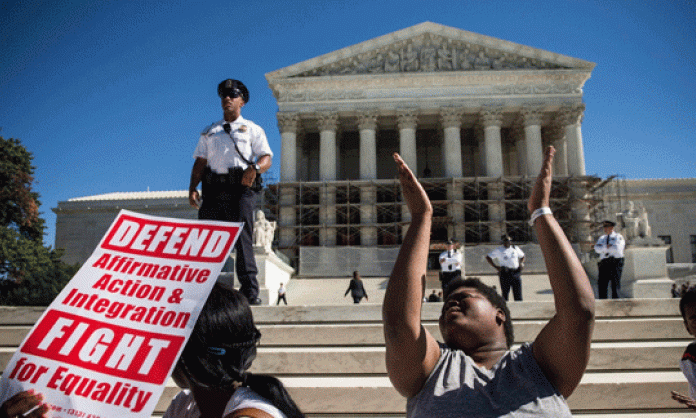The US Supreme Court on 22 April ruled that states can ban affirmative action in admissions to public universities.
At issue was a constitutional amendment passed in Michigan that banned consideration of race in admissions to the state’s schools.
States that forbid affirmative action in higher education have had a significant drop in Black and Latino enrolments.
The racist ruling came on top of last year’s gutting of the 1965 Voting Rights Act.
Affirmative action and federal enforcement of the right to vote were two legal gains of the civil rights struggles of the 1950s and 1960s. Both have been whittled away in the decades since; the Supreme Court has now given more encouragement to racist moves against those gains.
The majority on the court used two arguments to justify their bigotry. One is the assertion, first raised by the far right, that the US is now a “colour blind” society.
Chief Justice John Roberts put this view in the Voting Rights decision, asserting: “The way to stop discrimination on the basis of race is to stop discriminating on the basis of race.” He claimed that enforcing the right of Blacks to vote is discriminatory.
The decision in the recent case was opposed by the court’s two women Justices. Sonia Sotomayor, a Latina, wrote a sharp dissent. In a play on Roberts’ earlier assertion, she said, “The way to stop discrimination on the basis of race is to speak openly and candidly on the subject of race, and to apply the Constitution with eyes open to the unfortunate effects of centuries of racial discrimination.”
It is of course true that the Black upsurge of “the sixties” – the mass marches, non-violent sit-ins and violent uprisings – overthrew the apartheid Jim Crow system and won gains throughout the country. But institutionalised racism persists.
This is evident in the patterns of continued de facto segregation in education and housing, rates of employment and unemployment, differences in wages, health etc, which are there for all to see. The US is not a “colour blind” society.
Sotomayor explained that without affirmative action, she would never have been able to attend an Ivy League school and would never have made it onto the Supreme Court.
The court’s only Black member, Clarence Thomas, also became a lawyer through taking advantage of affirmative action. In his case, however, he is against any other Blacks being helped by affirmative action, and is consistently on the court’s right wing, for example in these two decisions. Thomas got his, and to hell with anyone else.
The other argument the majority used in this new ruling is “states’ rights”. That is, it is up to the states to discriminate as they see fit.
This is an old and hoary excuse that goes back to the founding of the US. It was written into the Constitution as a justification for slavery in those states whose economies were based on involuntary labour. It took another revolution, the bloody Civil War, to overthrow this mode of production.
In the period of Radical Reconstruction following the Civil War, the defeat of the slavocracy was codified in the 13th, 14th and 15th amendments to the Constitution.
In the period of reaction beginning in 1877 that followed Reconstruction, the Jim Crow system in the south and de facto racial discrimination in the rest of the country were also justified by “states’ rights”.
The Reconstruction amendments, especially the right of Blacks to vote in the south, were largely ignored. It was not until the great Black liberation movement of the middle of last century that Jim Crow was overthrown.
These two decisions by the Supreme Court further chip away at those gains, and are another indication of the move to the right in bourgeois politics.










